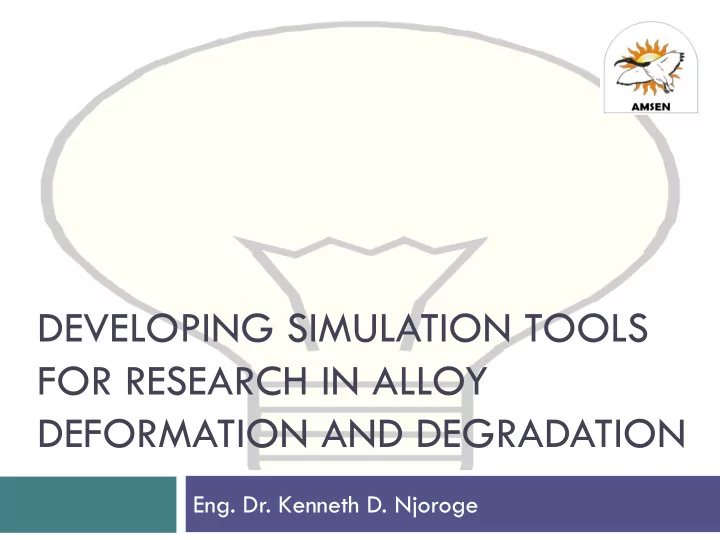

DEVELOPING SIMULATION TOOLS FOR RESEARCH IN ALLOY DEFORMATION AND DEGRADATION Eng. Dr. Kenneth D. Njoroge
PROCESSING OF ALLOYS 2 Mineral Mineral processing Recycling extraction Base metal products: e.g. Ingots/ slabs Metal forming/casting Surface Heat treatment & specialized treatments processing methods Metal products
PROCESSING AND APPLICATION NEEDS 3 A: ¨ Achievable melting points and lower energy consumption ¨ Controlled plastic flow during forming ¨ Techniques to enhance desired properties B: ¨ Ability to forecast material properties – development and processing ¨ Ability to forecast component performance - application
RATIONALE FOR ENGINEERING SIMMULATION - I 4 ¨ Current approach: use empirical tests to generate data to enable one forecast behavior and performance; ¤ Very effective ¤ Requires specialized equipment – quite often high value ¤ Tests may be expensive Microstructure Empirical Properties Performance Testing
RATIONALE FOR ENGINEERING SIMMULATION - II 5 ¨ New approach: use computers to simulate behavior; ¤ Lower evaluation cost ¤ A larger volume of data can be generated ¤ Easily applied to the geometry of the part ¤ Allows easy replacement of material Material Component properties geometry Simulation Material Performance processing
VALUE FOR MULTISCALE MATERIALS MODELING 6 ¨ Eliminates the need to assume some underlying mechanism that drives the material’s behavior Transfer models Grain boundary models Nano to micro-scale aggregation models Atomic scale models
CHALLENGES TO SIMMULATION BASED RESEARCH 7 ¨ Is limited to computational power and accuracy of scientific models used ¨ Requires development of simulation tools ¨ Needs validation using fundamental empirical data
CURRENT EFFORT 8 ¨ Material is normally built by basic building blocks of differing sizes, shape, orientation and physical structure ¨ Need to establish mechanism for the interaction of building blocks – information required by the simulation tools ¨ Intervention – develop algorithms to manage the variation of the building blocks and the aggregation of their contribution.
OUR STRENGTHS 9 Fundamentals and opportunities of multi-scale modeling using ¨ EAM are well understood Capacity to develop simulation code has been demonstrated ¨ 2 element BCC alloy - code developed. Can be enhanced to ¨ include: More elements ¤ FCC & HCP structures ¤ Capacity to develop models for simulation of material ¨ evolution has been demonstrated
OPPORTUNITIES 10 Substantial foundational knowledge exists in micro/nano-scale ¨ materials evolution mechanisms Scalable architecture for a cluster HPC platform enables ¨ progressive investment Use collaboration to meet specialized validation efforts ¨ Pool of candidates for training in materials modeling ¨
RESEARCH VISION 11 Allow for variation in the alloy content ¨ Develop transferable models suitable for multi-element alloys ¨ Develop materials and engineering multi-scale simulation tools ¨ Apply simulation tools to study industry needs: e.g. roll ¨ forming, protection against corrosion, wear reduction, etc Develop a pool of competent computational materials ¨ scientists Develop computational materials modeling as a viable ¨ research technique for industrial development
CURRENT PROJECTS 12 Simulation of Crack Propagation in a Pressure Vessels using ¨ the Energy J-Integral Method: J. K. Mutava, M.Sc. JKUAT Liner Wear Reduction in a Single Toggle Jaw crusher, G. ¨ Quartey, M.Sc. JKUAT Stress Analysis of Buried Oil Pipelines in Earthquake Prone ¨ Areas, L. Kikande, M.Sc. JKUAT
PROPOSED PROJECTS - I 13 Corrosion modeling ¨ Modeling of element contribution to corrosion resistance in ¤ nodular cast irons for the oil and gas industry valves and fittings Modeling of corrosion mechanisms in sour gas oil pipelines ¤ Modeling of corrosion mechanisms in construction steels for ¤ marine vessels Modeling of corrosion mechanisms in rebar in water retention ¤ concrete structures Corrosion protection ¨ Development of coatings for sour gas oil pipeline protection ¤
PROPOSED PROJECTS - II 14 DEM modeling of material flow & Wear modeling in the ¨ commutation processes, in selected mining equipment Variable roll forming ¨ Development of Ab-initio capacity ¨
GROUP PHILOSOPHY 15 Existing knowledge: Bonding behavior, Lattice evolution, Grain & grain boundary evolution, Bulk material behavior. Resources Our research New knowledge: Transferable multi-scale Application: models; Applied plasticity; Simulation tools corrosion; wear; industrial solutions; etc
Recommend
More recommend